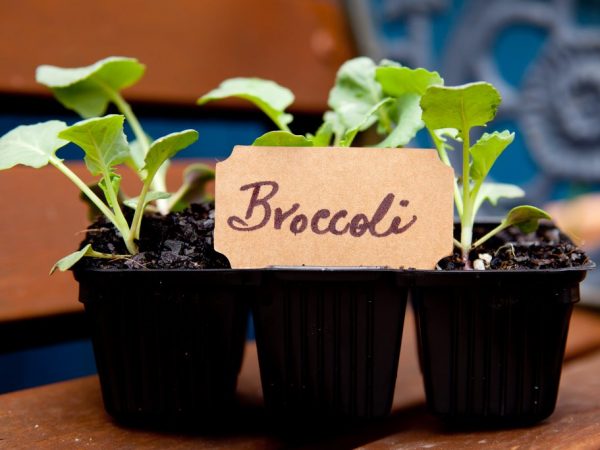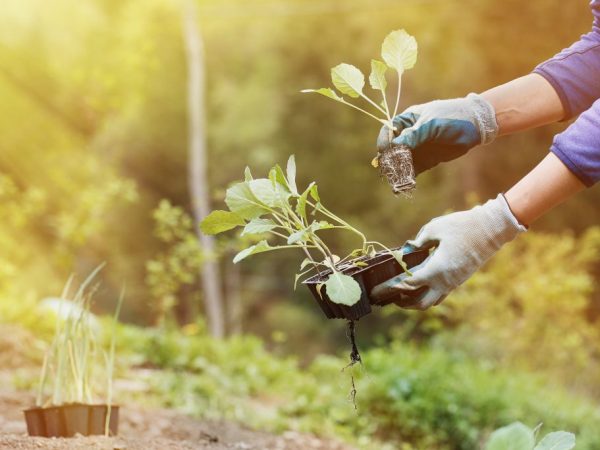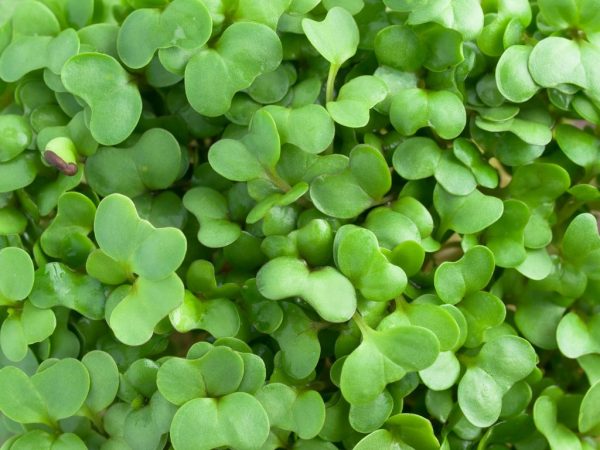Planting broccoli seedlings
Cabbage has long been one of the most important components of the human diet. There are many varieties of the popular vegetable, but each has its own quirks when grown by seed. How is the correct planting of broccoli seedlings and what are the basics of care? Let us analyze the most important points of agricultural agricultural technology.

Planting broccoli seedlings correctly
Preparatory procedures
Seat selection
Before planting broccoli for seedlings with seeds, choose a suitable place for growth. Like white-headed species, these varieties prefer to grow in illuminated parts of the garden with little shade in the form of bushes or young trees. The culture does not like closely adjacent groundwater and acidic soil. The recommended alkaline reaction of the earth should be in the range of 6.7-7.5 units. If the indicators are higher, it is advised to alkalinize with lime.
Planting a certain culture in one place every year, it is difficult to achieve the productivity of the variety. There are plant species that have the same diseases and pests.
Unfavorable predecessors
According to the rules of crop rotation, planting seedlings for growing broccoli cabbage is prohibited after:
- radish;
- watercress;
- tomatoes;
- radish;
- any kind of cabbage.
The culture will not be able to develop normally and give a bountiful harvest in this area for 4 years.
Favorable predecessors:
- cereals;
- cucumbers;
- siderates;
- legumes;
- potato.
Site preparation
In the fall, the future planting site is carefully dug up, weeds are removed and fertilizers are applied. For 1 sq. m you need about 4.5 kg of manure or compost. In the spring, the site is loosened again, and 3 weeks before planting the plants in the ground, the soil is sprayed with a 3% solution of Bordeaux liquid.
Seeds
To grow vegetables efficiently, you need high-quality seed. The first step is to carefully examine the seeds, rejecting specimens less than 1.5 cm: they have too little nutrients, so it is difficult to get healthy plants.
Before sowing broccoli for seedlings, all seeds are hardened: they are immersed in hot (no more than 50 ° C) water for 3 minutes, after which they are cooled in a cool liquid for the same time. To protect against fungi, the seeds are soaked in a solution of any fungicide (Fitosporin-M, Maxim Dachnik).
The growth activator - "Epin", "Zircon" or "Kornevin" helps to improve germination. The material is left in the preparation, diluted according to the instructions, for 6-8 hours, after which it is pulled out onto a napkin and dried. During the procedure, some grains may float, which indicates their non-viability.
Those who plan to grow broccoli for seedlings should pay attention to the ripening time. For warm regions, late varieties are relevant, characterized by long keeping quality and a long growing season - from 120 days or more. In temperate climates - from 100 days. In Siberia and the Urals, it is better to give preference to early plants that can reach within 3 months.
Growing seedlings

Seedlings in a few weeks
In the conditions of the domestic climate, cultivation takes place both by direct sowing into the ground and by seedling. The latter method allows you to completely control the development of young growth for several weeks. If you follow the rules, the seedlings will grow strong and healthy.
Sowing
The timing of planting is as follows: the culture after pecking from the grains will take 30-45 days, therefore, in the Middle Lane, planting in open ground occurs in late April and early May, while sowing seedlings is advised to be carried out in the last days of February and in March. In cool regions, stable heat comes 3-4 weeks later, so the dates are individually corrected.
You can plant broccoli for seedlings from seeds in a container with prepared soil. An hour before the procedure, the ground is thoroughly irrigated, water is drained from the pan. Holes are made in the soil, the depth of which should not exceed 1.5 cm and with a distance of 3 cm. 3 grains are placed in each hole, after which they are buried. If everything went right, the sprouts will come out in 5 days.
Until the emergence of shoots, the box is kept at a temperature of 20 ° C in a shaded place. After pecking, the seedlings are rearranged to the light, and the heat is reduced during the day to 16 ° C, at night - to 11 ° C. So that the plants do not get sick with a black leg, they monitor the soil moisture and the presence of ultraviolet radiation. If the culture is provided with cool development and supplemental lighting with a phytolamp, the seedlings will not stretch.
Care
The cabbage is given the correct regimen for several weeks. The first top dressing is applied no earlier than 21 days after germination. At a younger age, organic and mineral fertilizers can cause root burns, which causes disease and crop death. Professionals recommend to carry out the procedure not by watering, but by spraying on the leaf.
After 3 adult plates are formed on the plant, they begin to dive. This is an optional event, optional, but most of the gardeners in such a simple way slows down the development of the tops. Disturbed bushes stop growing foliage and move on to the regeneration of underground parts. By the end of the cultivation of seedlings, strong specimens with a developed root system are obtained.
After the pick, broccoli seedlings are protected from the sun for several days by building a shelter, and the room temperature is raised to 21 ° C.
Be sure to monitor the moisture content of the soil. At low temperatures, dry ground and insufficient lighting, ailments such as a black leg are activated. To protect the planting, it is advised to irrigate as needed and water the bushes with Fitosporin-M once every 3 weeks.
Landing in the ground
After 30-45 days, the seedlings are ready for planting in a permanent place of growth. An indicator of developed bushes is at least 5 adult leaves on the stem and a formed root system. At least 10 days before the start of agricultural work, the culture is hardened, gradually reducing the day and night temperatures, and they are also accustomed to the rays of the open sun.
After the cultivation of broccoli cabbage seedlings has come to an end, they begin to prepare the beds. 50 cm are left between the rows, and 40 cm between the pits. The holes are dug 20 cm deeper than the length of the roots.
A nutritious pillow is placed on the bottom of:
- compost;
- ash;
- dolomite flour.
There is enough fertilizer for the plant for 3 weeks of active development and formation of tops. Disembarkation is best done in cloudy weather or in the evening. 2 hours before the event, the pits are abundantly irrigated with water (at least a liter), and then work begins. The bushes are carefully placed on the "pillow", after which they are crushed with earth, then they are watered again and the fallen seedlings are raised.
To protect vegetables from recurrent frosts, planting is covered with polyethylene at night. If you grow a crop under lutrasil for the first weeks, the dangerous cruciferous flea insect will not pester young plants.
After 3 days, the soil is mulched at the roots.
Care

Healthy cabbage
Broccoli is healthy, so gardeners love to plant it on their own plot. To get a rich harvest, the plant needs to create all the conditions.
Irrigation
The culture is very hygrophilous, therefore, in the summer, watering is carried out once every 2 days, and in the heat - twice a day. For normal development and formation of inflorescences, the soil is kept wet at a depth of 15 cm. The event is carried out in the evening after the sun has set. Ultraviolet light damages young growth, so in the first weeks it is better to shade the bushes.
Before each irrigation, the hardened crust is gently loosened, weeds are removed. Due to the high humidity, growing broccoli from seedlings requires extreme care. It is important to ensure proper aeration of the roots, otherwise the underground parts will rot. To facilitate maintenance, it is advised to mulch the beds.
Top dressing
To get a bountiful harvest of a healthy vegetable, it is necessary to provide the plant with regular fertilization. Broccoli belongs to the "gluttonous" crops, so there are 3 mandatory procedures:
- After rooting. After the seedlings have grown, they are watered with top dressing. To do this, a glass of organic matter is dissolved in a bucket of water, gently irrigated at the root, trying not to get on the stem and foliage.
- In two weeks. A matchbox of nitrate is diluted in 10 liters of liquid. Each bush will need at least 1 liter of solution.
- Formation of heads. During this period, potassium-phosphorus preparations are needed, which improve yields. Add 10 g of potassium sulfate, 45 g of superphosphate and 20 g of nitrate to a bucket of water. All components are thoroughly mixed, and then poured under the plants.
After the central head is cut off, the lateral processes are stimulated. It is difficult to do this without fertilizers, so 35 g of potassium, 15 g of nitrate and 20 g of superphosphate are diluted in 10 liters of liquid. If the dosage is reduced by half, the solution can be used for sheet-by-sheet treatments. This procedure brings nutrients to the plant faster.
Fertilization is carried out after irrigation, otherwise the roots suffer. The crop will have to recover from stress, which will move the harvest time. It is not recommended to get carried away with nitrogen and organic fertilizing, as they provoke the occurrence of root rot.
Possible problems
Agricultural engineering mistakes are common not only for beginners, but also for experienced farmers. It is important to identify the disease or pest, and then proceed with immediate action. The less time you spend growing, the more problems.
Diseases
The most common ailments in broccoli are fungi. Pathogens develop in moist soil with thickened plantings, therefore it is recommended not to save space when growing cabbage. Among the popular diseases are:
- rot (white and gray);
- mosaic;
- alternaria;
- peronosporosis;
- fusarium wilting.
Fungi are afraid of copper-containing preparations, therefore, in the early stages of development, treatment with Bordeaux liquid is allowed. During the formation of inflorescences, it is advised not to stress the plants and choose a more gentle method. The Topaz fungicide effectively fights ailments, but the best option is to pre-soak the seeds.
Insects
Broccoli is annoyed by cruciferous fleas, aphids or slugs. In addition, a large number of flies prefer to feast on leaves.
If there are few insects, then it is easy to pick them up by hand or crush them on the tops. In case of significant damage, the plants are sprayed with a soapy solution with the addition of ash. To quickly get rid of parasites, they are treated with insecticides (Aktellik, Rovikurt, Foksima).
A mixture of tobacco dust, lime and charcoal is poured from snails and slugs along the beds. Sometimes slate sheets installed overnight help. Mollusks hide under them from the heat of the day, the agrarian can only gather the guests and destroy them.
To grow broccoli seedlings from seeds, you need to know all the requirements of the culture. A bountiful harvest will go to a farmer who can properly plant and care for broccoli seedlings at home.


